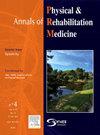The effects of digital health on exercise adherence and intervention outcomes in older adults with knee diseases: A systematic review
IF 4.6
3区 医学
Q1 REHABILITATION
Annals of Physical and Rehabilitation Medicine
Pub Date : 2025-03-12
DOI:10.1016/j.rehab.2025.101952
引用次数: 0
Abstract
Background
Poor adherence is commonly observed as one of the characteristics of exercise interventions and there is little consensus as to whether digital interventions promote exercise adherence in people undergoing physiotherapy, especially in older adults with knee diseases.
Purpose
To investigate the effects of digital health for improving the exercise adherence and intervention outcomes.
Methods
A systematic search was conducted on 4 databases; PRISMA reporting guidelines were followed. Journal articles in English (published till June 30, 2024) reporting digital health on exercise adherence and intervention outcomes for older adults with knee diseases were searched, and eligible articles underwent data extraction and a thematic synthesis.
Results
Of the 1015 potentially relevant trials, 13 studies totaling 1258 participants were eligible for inclusion. Digital health was slightly better but not significant than non-digital health on total adherence (SMD 0.29, 95 % CI ˗0.02 to 0.60; P = 0.07; I2 = 77 %). At short-term follow-up, digital health improved adherence compared with nondigital health (SMD 0.70, 95 % CI 0.39–1.01; P < 0.001; I2 = 4 %), with a very low certainty of evidence. At mid- and long-term, digital health was no better than non-digital health on adherence (mid-term: SMD 0.01, 95 % CI ˗0.55 to 0.58; P = 0.97; I2 = 86 %; long-term: SMD 0.09, 95 % CI ˗0.31 to 0.49, P = 0.66; I2 = 48 %). For the intervention outcomes, digital health reduced the pain only at short-term and was no better than non-digital health on physical function, ADL or QoL at any time point.
Conclusion
The available evidence is insufficient to draw the conclusion that digital health technology improves exercise adherence and intervention outcomes in older people with knee disease, and there is very low to low certainty of evidence supporting improvements of adherence and pain only at short-term. Larger-scale, more reliable studies and strategies are needed to enhance mid- and long-term adherence and intervention outcomes in older adults.
数字健康对老年膝关节疾病患者运动依从性和干预结果的影响:系统综述
运动干预的一个常见特征是坚持性差,对于数字干预是否能促进接受物理治疗的人,特别是患有膝关节疾病的老年人的运动坚持性,人们几乎没有共识。目的探讨数字健康对改善运动依从性和干预结果的影响。方法系统检索4个数据库;遵循了PRISMA报告准则。检索了报告老年膝关节疾病患者运动依从性和干预结果的数字健康的英文期刊文章(发表至2024年6月30日),并对符合条件的文章进行了数据提取和主题综合。在1015项可能相关的试验中,13项研究共计1258名受试者符合纳入条件。数字医疗在总依从性方面略好于非数字医疗,但并不显著(SMD = 0.29, 95% CI = 0.60;P = 0.07;I2 = 77%)。在短期随访中,与非数字健康相比,数字健康改善了依从性(SMD 0.70, 95% CI 0.39-1.01;P & lt;0.001;I2 = 4%),证据的确定性非常低。从中长期来看,数字医疗在依从性方面并不优于非数字医疗(中期:SMD为0.01,95%可信区间为:0.55 - 0.58;P = 0.97;I2 = 86%;长期:SMD为0.09,95%可信区间为0.31 ~ 0.49,P = 0.66;I2 = 48%)。对于干预结果,数字健康仅在短期内减轻了疼痛,并且在任何时间点的身体功能,ADL或QoL方面并不优于非数字健康。结论现有证据不足以得出数字健康技术改善老年膝关节疾病患者运动依从性和干预结果的结论,并且证据的确定性非常低至低,只能在短期内改善依从性和疼痛。需要更大规模、更可靠的研究和策略来提高老年人的中长期依从性和干预结果。
本文章由计算机程序翻译,如有差异,请以英文原文为准。
求助全文
约1分钟内获得全文
求助全文
来源期刊

Annals of Physical and Rehabilitation Medicine
Medicine-Rehabilitation
CiteScore
7.80
自引率
4.30%
发文量
136
审稿时长
34 days
期刊介绍:
Annals of Physical and Rehabilitation Medicine covers all areas of Rehabilitation and Physical Medicine; such as: methods of evaluation of motor, sensory, cognitive and visceral impairments; acute and chronic musculoskeletal disorders and pain; disabilities in adult and children ; processes of rehabilitation in orthopaedic, rhumatological, neurological, cardiovascular, pulmonary and urological diseases.
 求助内容:
求助内容: 应助结果提醒方式:
应助结果提醒方式:


